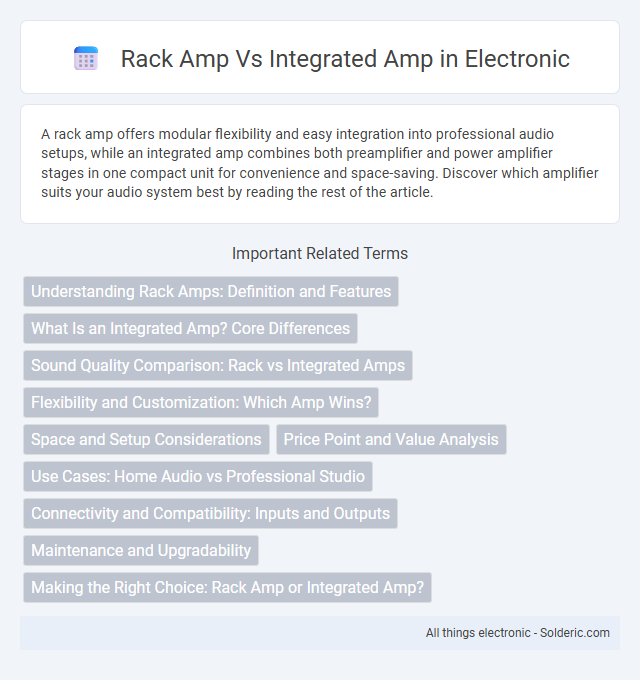A rack amp offers modular flexibility and easy integration into professional audio setups, while an integrated amp combines both preamplifier and power amplifier stages in one compact unit for convenience and space-saving. Discover which amplifier suits your audio system best by reading the rest of the article.
Comparison Table
| Feature | Rack Amplifier | Integrated Amplifier |
|---|---|---|
| Design | Mounts in equipment racks; compact and space-saving. | Standalone unit combining preamp and power amp. |
| Use Case | Professional audio setups and studios. | Home audio and hi-fi systems. |
| Components | Power amplifier only; needs separate preamp. | Includes both preamplifier and power amplifier. |
| Portability | Less portable; requires rack mounting. | Easy to move and place anywhere. |
| Audio Quality | High power output; suitable for professional use. | Optimized for balanced sound in consumer environments. |
| Connectivity | Multiple input/output for flexible routing. | Standard consumer connectors. |
| Price | Typically higher due to professional grade. | Varies; often more affordable for consumers. |
Understanding Rack Amps: Definition and Features
Rack amps are amplifiers designed to be mounted in standard 19-inch equipment racks, offering space-saving integration ideal for studio and live sound setups. These units often provide robust power output, multiple input/output options, and advanced control features such as remote switching and built-in effects processing. Understanding the compact design and connectivity of rack amps can help you optimize your audio system for flexibility and professional performance.
What Is an Integrated Amp? Core Differences
An integrated amp combines a preamplifier and power amplifier in one unit, streamlining audio signal processing and power delivery. Unlike rack amps, which are typically modular and designed for customizable, professional setups, integrated amps offer simplicity and space-saving advantages for home audio systems. Core differences include integrated amps' compact design and ease of use, while rack amps provide greater flexibility and scalability for complex sound configurations.
Sound Quality Comparison: Rack vs Integrated Amps
Rack amplifiers often deliver superior sound quality due to their specialized components and dedicated design for high-fidelity audio reproduction, minimizing signal interference and distortion. Integrated amplifiers combine preamp and power amp sections in one unit, which can sometimes introduce slight signal degradation but offer convenience and fewer cables. Audiophiles typically prefer rack amps for cleaner, more powerful sound, while integrated amps provide balanced performance suitable for most listening environments.
Flexibility and Customization: Which Amp Wins?
Rack amps offer superior flexibility and customization due to their modular design, allowing you to easily upgrade or swap components for tailored performance. Integrated amps combine preamp and power amp sections into a single unit, limiting customization but ensuring streamlined functionality. For audiophiles seeking adaptability, rack amps provide the advantage of personalized setups unmatched by integrated amps.
Space and Setup Considerations
Rack amps offer a compact, organized solution ideal for studios or setups with limited space, allowing multiple units to be stacked efficiently within a standardized rack system. Integrated amps, while often bulkier due to combining preamp and power amp sections, require dedicated shelf or stand space but offer a simpler setup with fewer cables and connections. Choosing between the two depends on available space, desired modularity, and ease of installation within the audio environment.
Price Point and Value Analysis
Rack amplifiers generally offer a lower price point compared to integrated amplifiers due to their modular design and focus on power delivery without built-in preamps or DACs. Integrated amplifiers combine multiple functions, often justifying higher costs with added features like preamps, DACs, and connectivity options, delivering greater value for users seeking all-in-one solutions. For budget-conscious buyers prioritizing pure amplification, rack amps provide cost-efficiency, while integrated amps appeal to those valuing convenience and audio versatility.
Use Cases: Home Audio vs Professional Studio
Rack amps are designed for professional studio environments, offering compact, durable, and easily mounted solutions tailored for controlled acoustics and precise audio monitoring. Integrated amps cater to home audio enthusiasts, combining preamp and power amp functions to drive speakers with rich sound quality, suitable for living room setups and casual listening. Your choice depends on whether you prioritize rugged, space-saving gear for professional mixing or flexible, user-friendly equipment for immersive home listening experiences.
Connectivity and Compatibility: Inputs and Outputs
Rack amps offer extensive connectivity options with multiple inputs and outputs designed for professional audio setups, supporting versatile device integration. Integrated amps typically provide a user-friendly array of inputs and outputs suitable for home audio systems, including analog, digital, and headphone connections. Your choice depends on the compatibility requirements of your audio gear and the complexity of your connection needs.
Maintenance and Upgradability
Rack amps often provide easier maintenance and upgradability due to their modular design, allowing you to swap or upgrade specific components without replacing the entire unit. Integrated amps combine the preamp and power amp sections, which can limit upgrade options and make repairs more complex or costly. For audiophiles seeking flexibility, rack amps offer a more adaptable solution for long-term use.
Making the Right Choice: Rack Amp or Integrated Amp?
Choosing between a rack amp and an integrated amp depends on your audio setup and space constraints; rack amps offer modularity and ease of integration into existing systems, making them ideal for professional or custom installations. Integrated amps combine preamplifier and power amplifier sections into one unit, providing convenience and simplicity for home audio enthusiasts. Evaluate factors such as system scalability, sound quality preferences, available space, and ease of use to determine the most suitable option for your needs.
rack amp vs integrated amp Infographic

 solderic.com
solderic.com